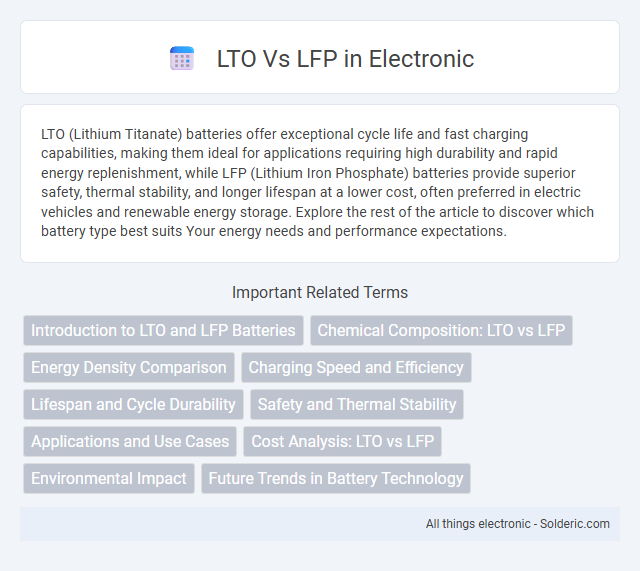LTO (Lithium Titanate) batteries offer exceptional cycle life and fast charging capabilities, making them ideal for applications requiring high durability and rapid energy replenishment, while LFP (Lithium Iron Phosphate) batteries provide superior safety, thermal stability, and longer lifespan at a lower cost, often preferred in electric vehicles and renewable energy storage. Explore the rest of the article to discover which battery type best suits Your energy needs and performance expectations.
Comparison Table
| Feature | LTO (Lithium Titanate) | LFP (Lithium Iron Phosphate) |
|---|---|---|
| Cycle Life | Up to 20,000 cycles | 2,000 - 4,000 cycles |
| Energy Density | 60-110 Wh/kg | 90-160 Wh/kg |
| Charge Rate | Fast charging (up to 10C) | Moderate (typically 1-3C) |
| Safety | Excellent thermal stability | High safety, stable chemistry |
| Cost | Higher upfront cost | Lower cost, widely available |
| Operating Temperature | -30degC to 55degC | -20degC to 60degC |
| Applications | Fast-charging EVs, grid storage, military | Electric vehicles, solar storage, backup power |
Introduction to LTO and LFP Batteries
LTO (Lithium Titanate Oxide) batteries use a unique anode material that enables rapid charging, exceptional cycle life, and enhanced safety compared to traditional lithium-ion batteries. LFP (Lithium Iron Phosphate) batteries are renowned for their thermal stability, long lifespan, and cost-effectiveness, making them a popular choice for electric vehicles and energy storage. Understanding these technologies can help you select the optimal battery type for high-performance applications and long-term reliability.
Chemical Composition: LTO vs LFP
Lithium Titanate Oxide (LTO) batteries utilize lithium titanate (Li4Ti5O12) as the anode material, characterized by a spinel structure that enhances stability and fast charging capabilities. Lithium Iron Phosphate (LFP) batteries employ lithium iron phosphate (LiFePO4) as the cathode, known for its olivine crystal structure, offering high thermal stability and safety. The distinct chemical compositions of LTO and LFP result in differing electrochemical properties, with LTO enabling longer cycle life and rapid charging, while LFP provides higher energy density and improved safety.
Energy Density Comparison
LTO (Lithium Titanate Oxide) batteries typically have lower energy density, around 60-80 Wh/kg, compared to LFP (Lithium Iron Phosphate) batteries, which offer approximately 90-160 Wh/kg, making LFP more suitable for applications requiring longer runtimes and lighter weight. Your choice between LTO and LFP should consider that LFP provides higher energy storage per unit mass, enhancing overall efficiency in electric vehicles and energy storage systems. LTO excels in fast charging and longer cycle life but sacrifices energy density, limiting its use where compact energy storage is critical.
Charging Speed and Efficiency
LTO (Lithium Titanate Oxide) batteries offer ultra-fast charging speeds, often achieving full charge in under 10 minutes due to their high charge acceptance and low internal resistance, making them ideal for rapid energy replenishment. LFP (Lithium Iron Phosphate) batteries provide moderate charging speeds, typically requiring 1 to 3 hours for a full charge, with higher charging efficiency and lower heat generation, which enhances battery lifespan and safety. LTO excels in scenarios demanding quick turnaround times, while LFP balances charging efficiency and thermal stability for longer cycle life.
Lifespan and Cycle Durability
LTO (Lithium Titanate Oxygen) batteries exhibit exceptional lifespan and cycle durability, often exceeding 10,000 charge-discharge cycles with minimal capacity degradation. In comparison, LFP (Lithium Iron Phosphate) batteries typically offer around 2,000 to 3,000 cycles before significant capacity loss occurs. The superior cycle life of LTO makes it ideal for applications requiring frequent and rapid charging over long operational periods.
Safety and Thermal Stability
LTO (Lithium Titanate Oxide) batteries offer superior safety and thermal stability compared to LFP (Lithium Iron Phosphate) batteries due to their excellent heat resistance and low risk of thermal runaway. LFP cells are inherently safer than many lithium-ion chemistries but can still experience thermal instability under extreme conditions. Your choice should consider LTO for applications demanding maximum safety and consistent performance at high temperatures.
Applications and Use Cases
LTO batteries excel in fast charging and high cycle life, making them ideal for electric buses, grid storage, and heavy-duty vehicles requiring quick energy delivery and long-term durability. LFP batteries offer superior thermal stability and are widely used in residential solar systems, electric cars, and portable electronics where safety and cost-effectiveness are crucial. Understanding your specific energy needs helps determine whether LTO's rapid discharge capabilities or LFP's reliable, steady output best suit your application.
Cost Analysis: LTO vs LFP
LTO batteries typically have a higher upfront cost compared to LFP due to advanced materials and manufacturing processes, but they offer longer cycle life and faster charging, which can reduce replacement and downtime expenses over time. LFP batteries are more cost-effective initially, benefiting from abundant raw materials and established production scales, making them suitable for applications with lower cycling demands. Your choice between LTO and LFP should consider total cost of ownership, balancing capital expenditure against longevity and performance efficiency.
Environmental Impact
LTO (Lithium Titanate Oxide) batteries boast a longer lifespan and higher recyclability compared to LFP (Lithium Iron Phosphate), reducing waste and environmental strain over time. LFP batteries contain abundant and less toxic materials, making them more eco-friendly during production and disposal processes. Your choice between LTO and LFP should consider the balance between environmental impact and battery efficiency.
Future Trends in Battery Technology
LTO (Lithium Titanate Oxide) batteries exhibit exceptional cycle life and fast charging capabilities, making them ideal for high-demand applications in electric vehicles and grid storage. LFP (Lithium Iron Phosphate) batteries offer enhanced thermal stability, safety, and cost-effectiveness, driving widespread adoption in renewable energy systems and electric transportation. Future trends indicate the rise of hybrid LTO-LFP technologies and solid-state electrolytes, aiming to combine the strengths of both chemistries for greater energy density, durability, and sustainable performance.
LTO vs LFP Infographic

 solderic.com
solderic.com